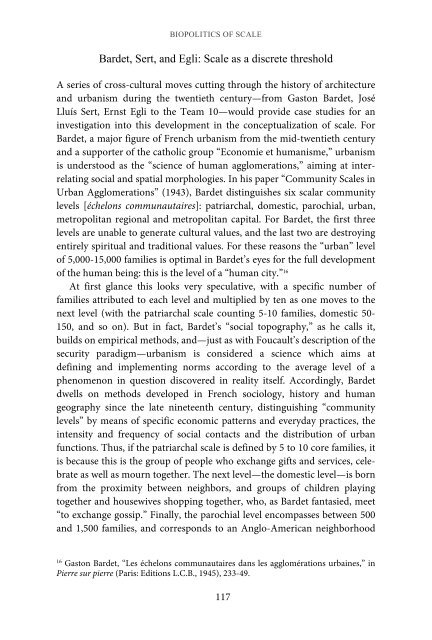Foucault, Biopolitics, and Governmentality
Foucault, Biopolitics, and Governmentality
Foucault, Biopolitics, and Governmentality
Create successful ePaper yourself
Turn your PDF publications into a flip-book with our unique Google optimized e-Paper software.
BIOPOLITICS OF SCALE<br />
Bardet, Sert, <strong>and</strong> Egli: Scale as a discrete threshold<br />
A series of cross-cultural moves cutting through the history of architecture<br />
<strong>and</strong> urbanism during the twentieth century—from Gaston Bardet, José<br />
Lluís Sert, Ernst Egli to the Team 10—would provide case studies for an<br />
investigation into this development in the conceptualization of scale. For<br />
Bardet, a major figure of French urbanism from the mid-twentieth century<br />
<strong>and</strong> a supporter of the catholic group “Economie et humanisme,” urbanism<br />
is understood as the “science of human agglomerations,” aiming at interrelating<br />
social <strong>and</strong> spatial morphologies. In his paper “Community Scales in<br />
Urban Agglomerations” (1943), Bardet distinguishes six scalar community<br />
levels [échelons communautaires]: patriarchal, domestic, parochial, urban,<br />
metropolitan regional <strong>and</strong> metropolitan capital. For Bardet, the first three<br />
levels are unable to generate cultural values, <strong>and</strong> the last two are destroying<br />
entirely spiritual <strong>and</strong> traditional values. For these reasons the “urban” level<br />
of 5,000-15,000 families is optimal in Bardet’s eyes for the full development<br />
of the human being: this is the level of a “human city.” 16<br />
At first glance this looks very speculative, with a specific number of<br />
families attributed to each level <strong>and</strong> multiplied by ten as one moves to the<br />
next level (with the patriarchal scale counting 5-10 families, domestic 50-<br />
150, <strong>and</strong> so on). But in fact, Bardet’s “social topography,” as he calls it,<br />
builds on empirical methods, <strong>and</strong>—just as with <strong>Foucault</strong>’s description of the<br />
security paradigm—urbanism is considered a science which aims at<br />
defining <strong>and</strong> implementing norms according to the average level of a<br />
phenomenon in question discovered in reality itself. Accordingly, Bardet<br />
dwells on methods developed in French sociology, history <strong>and</strong> human<br />
geography since the late nineteenth century, distinguishing “community<br />
levels” by means of specific economic patterns <strong>and</strong> everyday practices, the<br />
intensity <strong>and</strong> frequency of social contacts <strong>and</strong> the distribution of urban<br />
functions. Thus, if the patriarchal scale is defined by 5 to 10 core families, it<br />
is because this is the group of people who exchange gifts <strong>and</strong> services, celebrate<br />
as well as mourn together. The next level—the domestic level—is born<br />
from the proximity between neighbors, <strong>and</strong> groups of children playing<br />
together <strong>and</strong> housewives shopping together, who, as Bardet fantasied, meet<br />
“to exchange gossip.” Finally, the parochial level encompasses between 500<br />
<strong>and</strong> 1,500 families, <strong>and</strong> corresponds to an Anglo-American neighborhood<br />
16 Gaston Bardet, “Les échelons communautaires dans les agglomérations urbaines,” in<br />
Pierre sur pierre (Paris: Editions L.C.B., 1945), 233-49.<br />
117


